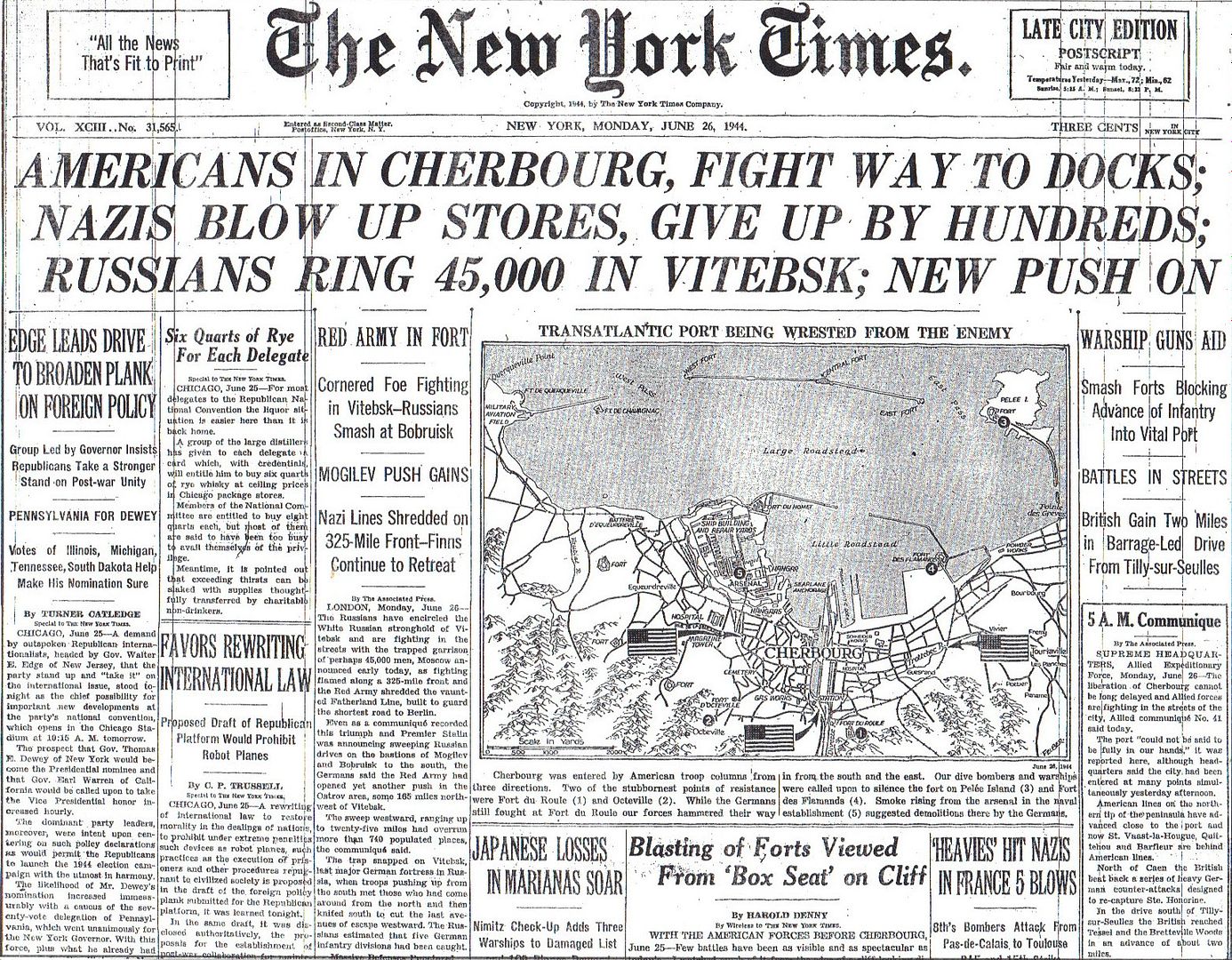
Posted on 06/26/2014 4:52:18 AM PDT by Homer_J_Simpson

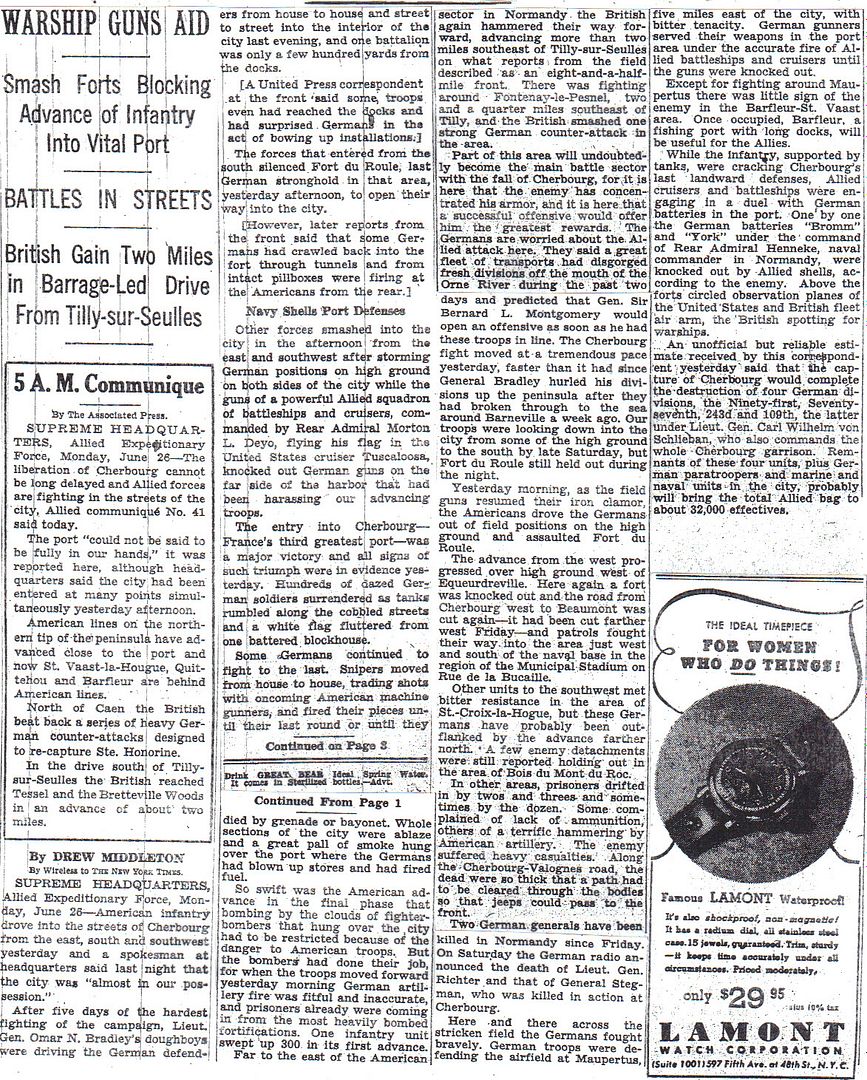
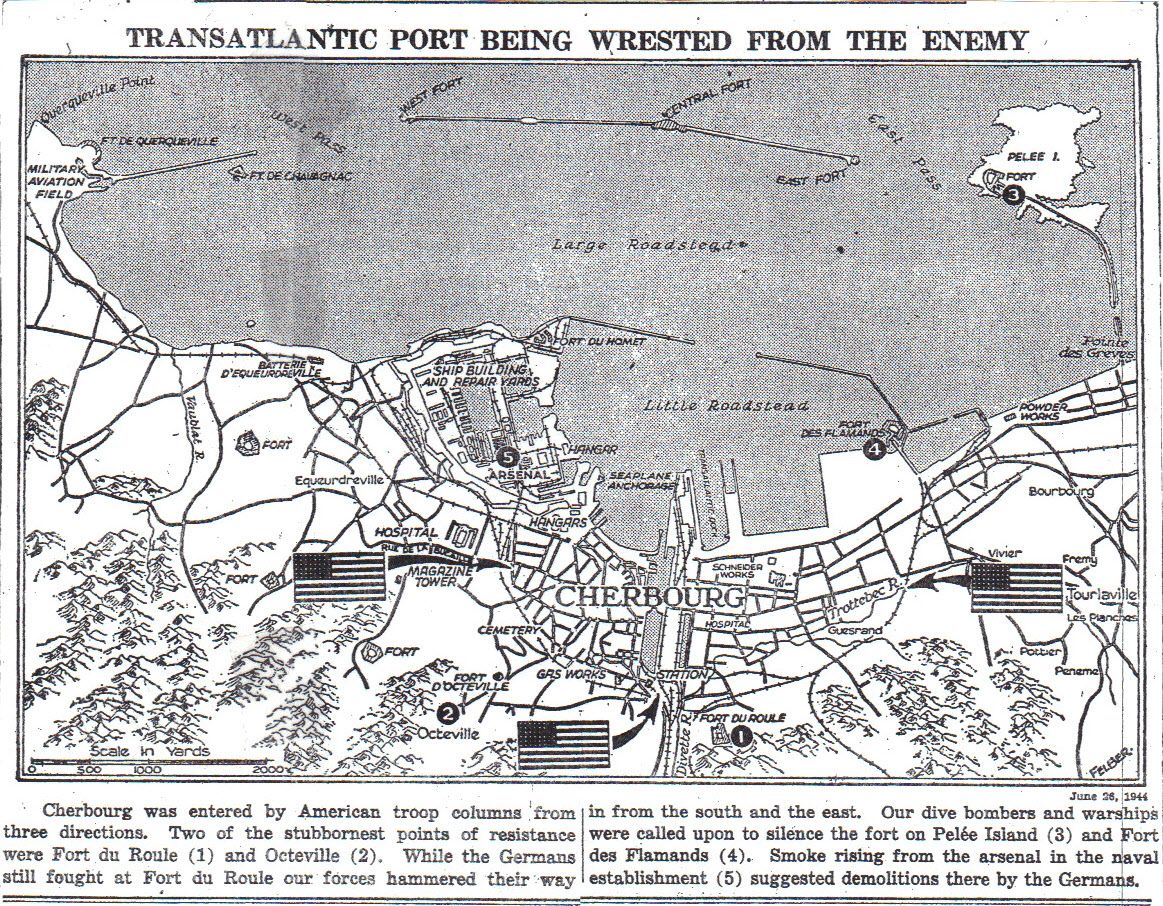
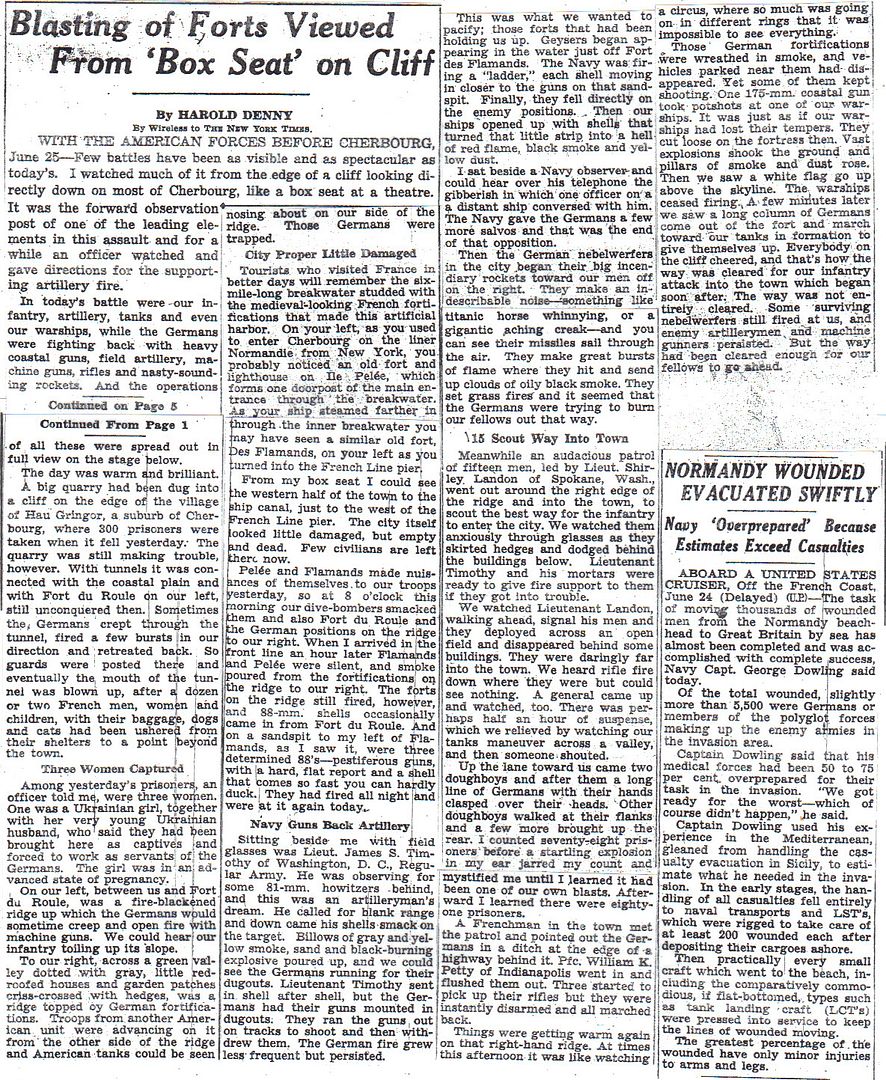
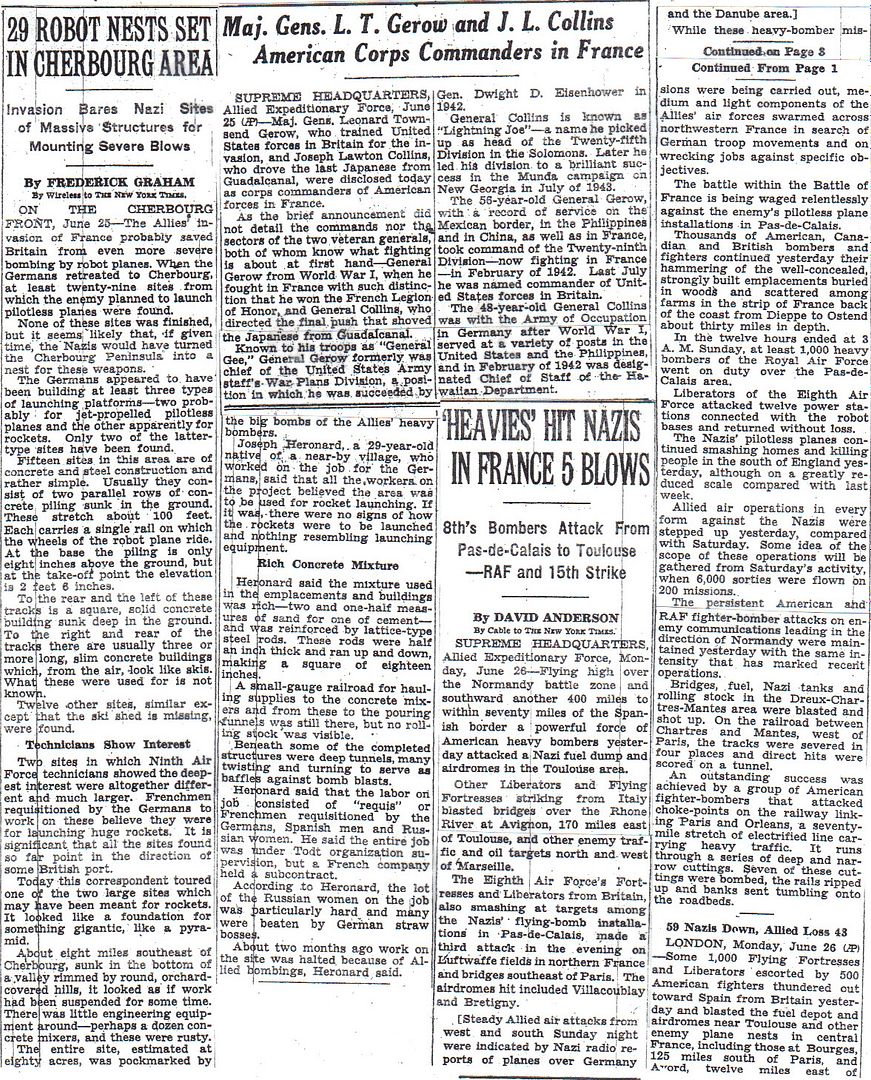
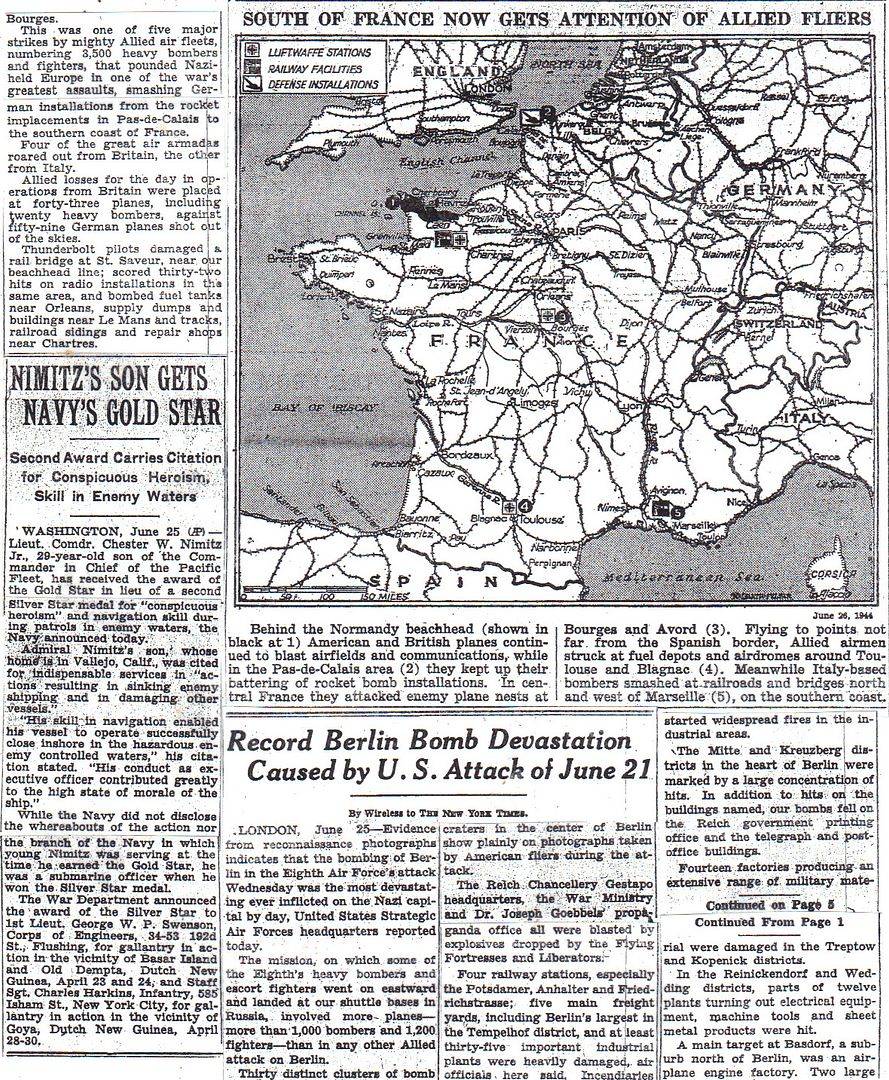


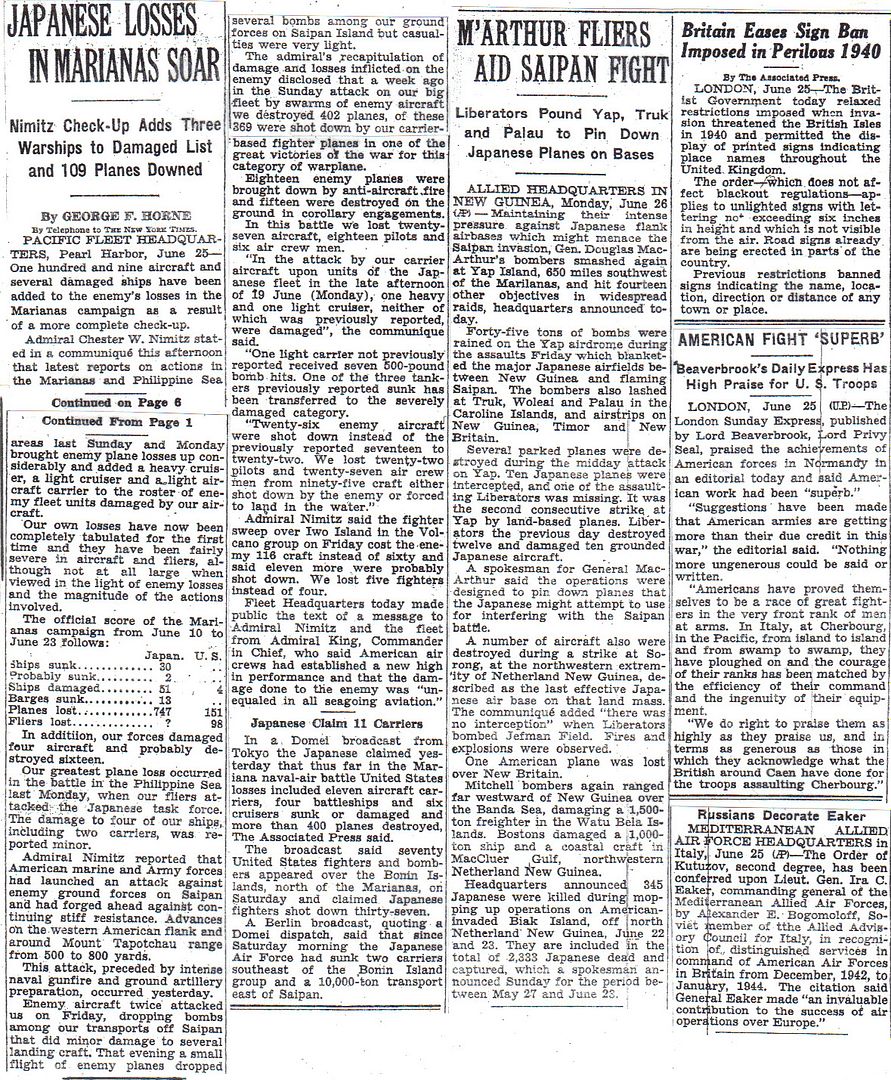
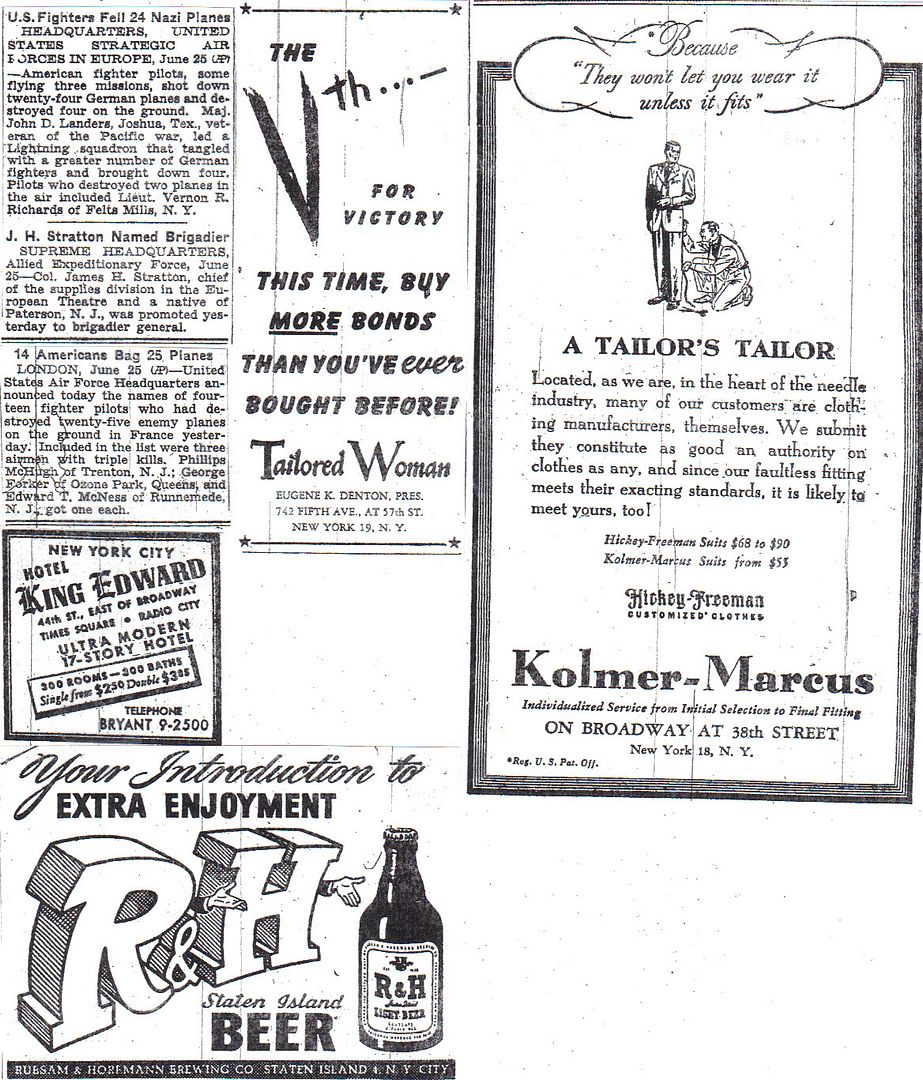
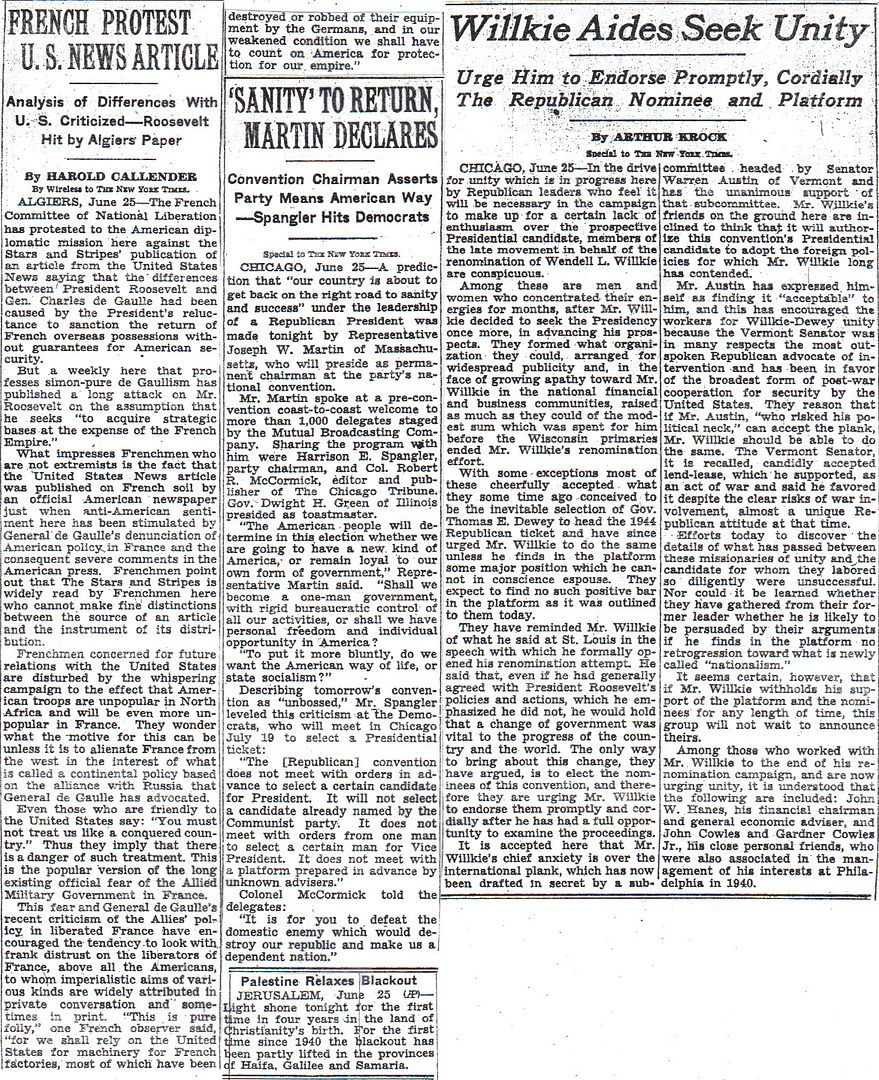
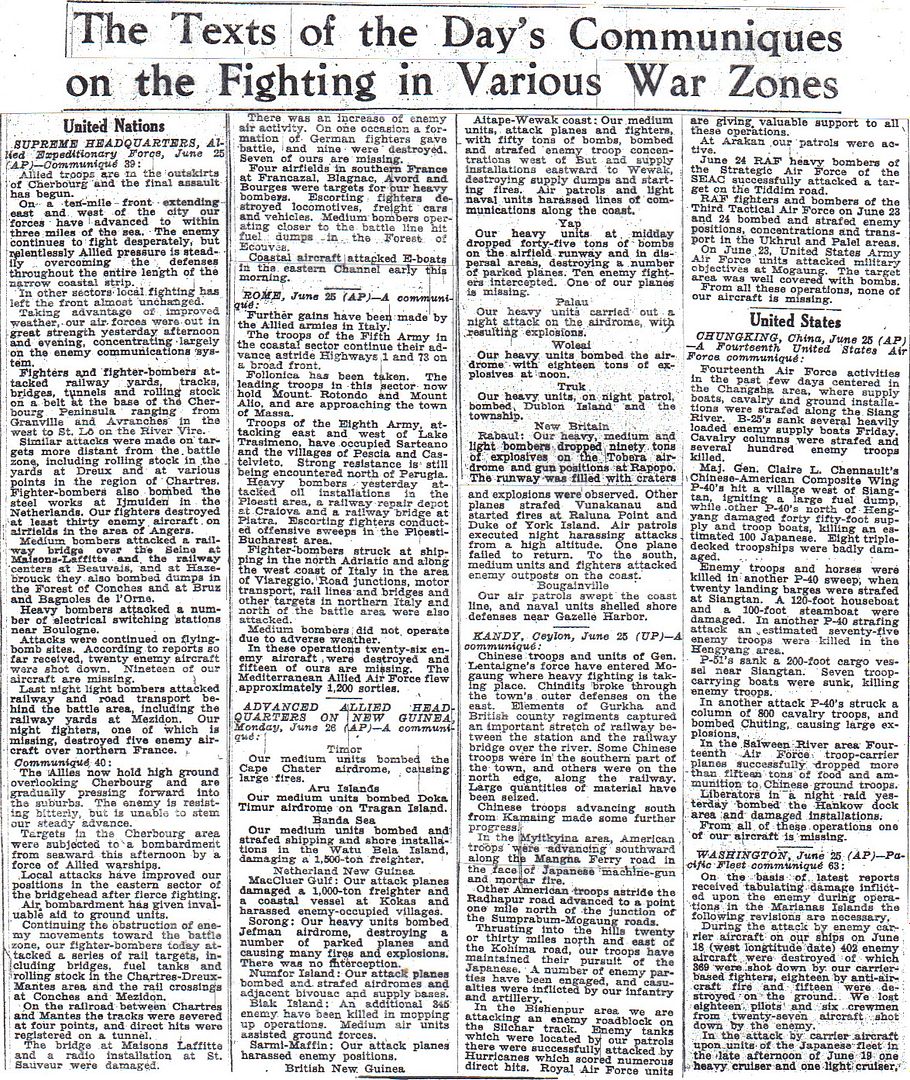

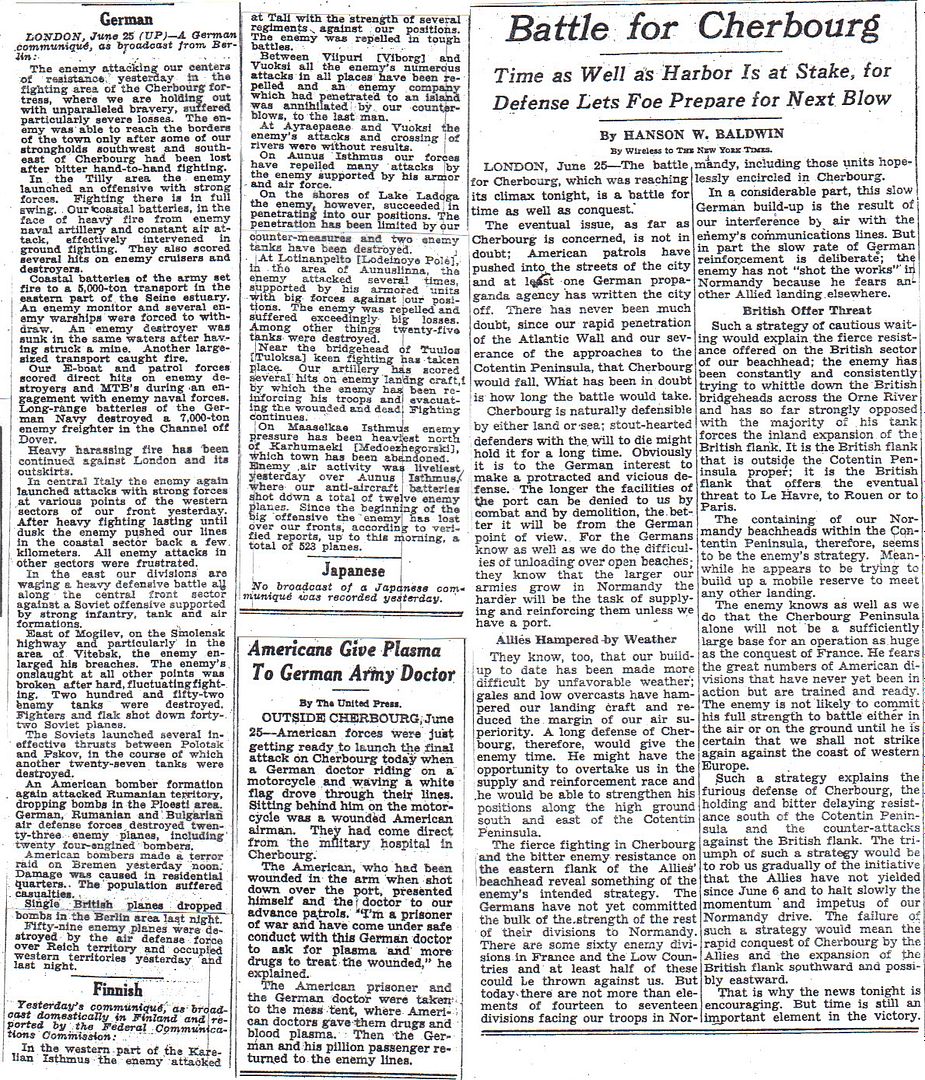
http://www.onwar.com/chrono/1944/jun44/26jun44.htm#
Germans reinforcements at Minsk
Monday, June 26, 1944 www.onwar.com
A German Tiger tank of sPzAbt. 505 [photo at link]
On the Eastern Front... Operation Bagration continues. At Vitebsk, elements of 3rd Belorussian Front penetrate the defenses of the trapped German 53rd Corps. During the night, a breakout is attempted but most of the 28,000 German troops are either killed or captured. Other elements of 3rd Belorussian Front capture Orsha, to the south, during the night. Forces of 2nd Belorussian Front capture Mogilev. The attacks of 1st Belorussian Front encircle Bobruisk, trapping 40,000 troops of German 41st Panzer Corps (part of 9th Army). Meanwhile, the first German reinforcements for Army Group Center arrive in Minsk: elements of the German 5th Panzer Division with sPzAbt. 505 attached.
On the Western Front... Most of Cherbourg, except the port, is now occupied by US 7th Corps (part of US 1st Army). The German garrison commander, General Schlieben and the naval commander, Admiral Hennecke, are taken prisoner. Meanwhile, British 2nd Army forces attacking toward Caen recieve naval support from HMS Rodney, the monitor Roberts and 3 cruisers.
In Italy... The French Expeditionary Corps (part of the US 5th Army) advances north of Radicofani while South African elements of the British 8th Army, to the right, capture Chiusi.
In the Mariana Islands... The American 5th Amphibious Corps continues attacking on Saipan. A small Japanese reinforcement convoy heading for the island is met and forced away by US forces.
In the Kurile Islands... Admiral Small leads a cruiser and destroyer group to bombard Japanese positions on Matsuwa.
http://www.etherit.co.uk/month/thismonth/26.htm
June 26th, 1944 (MONDAY)
FRANCE: Cherbourg: This morning the Germans start to destroy all port facilities.
Most of Cherbourg, except the area around the docks has been captured today by the US VII Corps, along with General Schlieben and Admiral Hennecke.
The US 22nd Infantry have been trying, unsuccessfully, to take the St. Marcouf battery on the Cotentin Peninsula. Its performance today leads to Major General Raymond O. Barton relieving the 22nd’s CO, Colonel Hervey A. Tribolet, of his command. Tribolet, in an interview on 27 August, 1944, in Paris, with the Historical Office of ETOUSA, attributed the poor performance of the regiment to overconfidence stemming from the ease of the fighting on D-Day. (James Knechtmann)
HMS Rodney (battleship) and HMS Roberts (monitor) with 3 cruisers bombard the area near Caen in support of British attacks.
Normandy: 5,287 Allied soldiers have been killed since D-Day.
Operation EPSOM: British 8 Corps attacks to seize crossings over the River Odon. Bad weather prevents virtually all aircraft from taking off from England. However, 83 Group, RAF, based in Normandy flies 500 sorties despite a heavy ground mist and low ground cover.
Bad weather cancels all USAAF Ninth Air Force operations save a few fighter sorties which result in claims against a few military vehicles and three aircraft as US ground forces capture Cherbourg; three US fighters are lost.
B.U.P. Message.
What is probably the strangest episode in this battle for Cherbourg occurred here this morning.
Just as the final attack was about to begin, a motor cycle driven by a German and with a US airman in the sidecar came through the battle lines, a white flag waving over it in the breeze.
Our advance patrols stopped it. They saw the airman was badly wounded in the left arm.
“I am a prisoner of war of the Germans,” he told them. “This officer is a German Army doctor. I have come from the military hospital in Cherbourg under a safe conduct with the doctor to ask for blood plasma and more drugs to treat the wounded there.”
They were taken to a command post, and the story was told again. A few minutes later they were being supplied with the necessary drugs by US Army doctors.
Then they went back, the doctor and the wounded airman, back through the lines into the besieged city of Cherbourg.
GERMANY: Obersalzberg: Hitler, forgetful and ill-looking, makes a confused and rambling speech to a group of leading industrialists.
FINLAND:
Battle of Tali-Ihantala
After midnight commander of the Finnish IV Corps Lt. Gen. Taavetti Laatikainen reshapes the command-structure around Tali by subordinating Maj. Gen. Paavo Paalu’s 18th Division to Maj. Gen. Ruben Lagus’s Armored Division. However, Gen. Lagus protests that he lacks the means to coordinate such a force, and isn’t well enough acquainted with the 18th Division’s situation. Gen. Laatikainen modifies the order, stating that the 18th Division shall act in cooperation with the Armored Division. The Finnish command-structure at Tali remains confused, and it influences adversely the fighting today.
In the early morning hours, the Armored Division continues its counter-attack towards Tali west of Lake Leitimonjärvi. These operations were directed by commander of the Jäger Brigade Col. Albert Puroma. Jäger Battalion 3, reinforced by assault guns, reaches around 2 am. the approximate level where the III/IR 13 had been in defence the previous morning. It destroys or captures eight enemy tanks on its way. Later Soviet counter-attack forces it to retreat back to the level it had reached by previous midnight. Between 8 and 9 am. Jäger Battalions 4 and 5, reinforced by elements from Maj. Eric Åkerman’s Assault Gun Battalion, settle into defence on the isthmus between lakes Kärstilänjärvi and Leitimonjärvi, while Jäger Battalion 3 withdraws to reserve around Portinhoikka.
But the most ambitious counter-attack is the attempt to encircle the Soviet spearhead east of Lake Leitimonjärvi by cutting it at the base. If succesful, two Soviet divisions (the 46th Guards and 286th) would be encircled in a large pocket north of Lake Leitimonjärvi.
Maj. Erkki Kaukolahti’s Jäger Battalion 2 starts its attack at 2 am. from west towards Talinmylly, while III/IR 48 attacks from north, and Separate Battalion 14 from east. At best Jäger Battalion 2 and Separate Battalion 14 are only 1 km from each other, but ultimately the counter-attack is stopped in morning by fierce Soviet resistance. The Finnish attacks were uncoordinated and ultimately too weak to attain the ambitious goal, and no reinforcements were available.
At 3.40 pm. commander of the Panzer Brigade Col. Sven Björkman is appointed CO of a detachment formed out of II/IR 13, Separate Battalion 14, III/48 and Maj. Martti Avela’s recently arrived Border Jäger Battalion 2. The mission: to reach Talinmylly, and from there advance south-east along the north-eastern shore of Lake Leitimonjärvi to Marjamäki on the isthmus between lakes Leitimonjärvi and Repolanjärvi. It was to be supported by a platoon of T-26 -tanks, five StuG IIIg -assault guns and an AT-detachment.
Battlegroup Björkman starts from Ihantala towards Talinmylly at 5.15 pm. However, the attack is soon aborted because of developments elsewhere.
In afternoon the Red Army begins to attack on both sides of Lake Leitimonjärvi, trying to recapture the Portinhoikka cross-roads and reach the road from Portihoikka to Ihantala. Around 3.30 pm. an enemy battalion manages to surprise Jäger Battalion 5 by attacking its rear from north of Lake Leitimonjärvi and drive it from its positions. Jäger Battalion 3 counter-attacks at 6 pm. and recaptures the lost positions.
More to north, a Soviet force reaches the Portinhoikka-Ihantala road later in the evening, cutting the road behind the Finns in Portinhoikka. Maj. Heikki Mikkola organizes a hasty force from an engineer company and one T-34-76 and six T-26 tanks that succesfully clear the road of enemy. But another Soviet force reaches the road at Nurmela, and remains there.
During today’s fierce battles, Finns are supported by artillery fire that is growing in accuracy and effect. Thanks to the pioneer work of General of Artillery Vilho Nenonen, Finland had one of the most effective artillery fire-control systems of the day, and it is beginning to show. As reinforcements reached Ihantala, Finnish artillery was to become a truly destructive force in the later phases of the battle. Also the Red Air Force didn’t have an undisputed control of the skies. Finnish bombers of Lt. Col. Birger Gabrielsson’s Aviation Regiment 4 are active today bombing Soviet troop-concentrations, together with Oberstleutnant Kurt Kuhlmey’s German Stukas.
But Maj. Gen. Paavo Paalu’s 18th Division is reaching the end of its tether. Its units, less than half-strength at the beginning of the battle, have worn further in today’s fighting. This evening and next night, 18th Division is relieved by Maj. Gen. Kaarlo Heiskanen’s fresh 11th Division. The 18th Division (minus its artillery, signals, supply and engineer units, which all stay on the battlefield) is taken to rear to rest and refit. Its commander also changes. Commander of the IV Corps Lt. Gen. Taavetti Laatikainen blames Gen. Paalu for today’s failures, and he is replaced by Col. Gustaf Snellman. With hindsight one can observe that the failures today were largely due the strength and determination of the Soviet forces, and it didn’t exactly help that Gen. Laatikainen chose to conduct the battle from his remote HQ without visiting the battlefield to get more up-to-date news.
Elsewhere in the Karelian Isthmus, on Lt. Gen. Hjalmar Siilasvuo’s III Corps’s right flank, the Red Army tries to eliminate the bridgehead Maj. Gen. Armas-Eino Martola’s 2nd Division has south of River Vuoksi at Vuosalmi. The Soviet attempts are repelled with the help of artillery. This is the beginning of the Battle of Vuosalmi.
The Soviet Union replies, to the Finnish peace feeler through Sweden on the 21st, that only unconditional surrender is accepted. (Gene Hanson)
Finnish President Ryti makes an agreement with Ribbentrop”>Ribbentrop, in which he declares that he will not start negotiating peace without acceptance from Germany.
This is the so-called Ribbentrop”>Ribbentrop-pact. Its importance lies in the fact that it was concluded personally, and thus was binding only as long as Ryti was in office. This was done intentionally by the Finns, who were already well aware that Germany was going to lose the war, but needed the German help to resist the Soviet offensive.
Amplifying the above:
When the Soviet offensive began on 9 June, it was immediately obvious, that a way out of the war has to be found as soon as possible. President of the Republic Risto Ryti was in daily contact with Marshal Mannerheim and Minister of Defence General of Infantry Rudolf Walden to stay informed of the situation on the fronts.
On 15 June Ryti had asked Mannerheim to become Prime Minister of a new cabinet. Mannerheim refused, stating that he can’t leave the duties of a Commander-in-Chief when the danger was the greatest. Two days later Ryti visited the GHQ, and told to Mannerheim he was ready to give up the presidency if Mannerheim took the post. Again Mannerheim refused.
The work to form a new cabinet that could better sue peace was hastened by Mannerheim, afraid that the front could collapse on any day. But then he stalled. The military situation was improving, and a new cabinet whose task was to make peace would endanger the German help flowing into country.
But on 21 June, day after the loss of Viipuri, President Ryti together with Foreign Minister Henrik Ramsay and Minister of Defence Gen. Walden attended a situation conference at the GHQ. Chief Quartermaster General Lt. Gen. Aksel Airo stated that the situation in the Karelian Isthmus was critical. It was possible the Red Army could break the Finnish resistance and advance into southern Finland. There were two options: peace at any cost, or help from Germany. Chief of General Staff General of Infantry Erik Heinrichs asked the German representative, General der Infanterie Waldemar Erfurth for six German divisions to man the Salpa-line (the request was dropped after the military situation stabilized). Earlier Sweden had rejected the Finnish plea for AT-weapons.
It was decided to contact the Soviet Union through Sweden. Finland stated it was willing to stop military operations, sever all relations with Germany and negotiate peace. But then came a surprising turn of events. On the afternoon of 22 June Finns were informed that the German Foreign Minister Joachim von Ribbentrop”>Ribbentrop would arrive Finland in few hours.
In the evening of 22 June Ribbetrop met with Ryti and Ramsay. He demanded that Finland won’t conclude peace with the Soviet Union unless in agreement with Germany. Without such a treaty, no German help would be forthcoming. Finns faced a difficult decision. Finland was dependant on German deliveries of food and weapons. Finally Finns decided that the German demand was acceptable, if the agreement not to leave the war was made by President Ryti _personally_. It was a very important reservation. If Ryti took the responsibility of the agreement personally, it wouldn’t bind his successor.
The decision was made far easier by the Soviet answer to the Finnish peace-feeler received on 23 June: ‘Because Finns had on several occasions betrayed us, we want Finland to give out a statement signed by President and Foreign Minister, that Finland is ready to surrender and turn to the Soviet government asking for peace. If we receive such a statement from the Finnish government, Moscow is ready to receive a Finnish delegation.’ In other words, the Soviet Union demanded unconditional surrender [*].
The choice was clear, and soon made. After long and hard negotiations with Ribbentrop”>Ribbentrop, Germans were content with an agreement signed by President Ryti, and Ryti only. By signing the agreement not to make peace unless in agreement with Germany, Ryti was consciously sacrificing himself. It is one of the ironies of history, that Ryti had always been an anglophile by nature.
On 26 June Ryti sent a letter to Hitler, stating Finland had decided to wage war against the Soviet Union, until ‘the threat presented by the Soviet Union to Finland has been removed’. Neither Ryti nor any cabinet appointed by him would seek peace with the Soviet Union.
Germans were happy, and the supplies kept flowing into Finland. But as soon as the military situation would permit, Mannerheim would become the President of the Republic, and make peace with better terms.
[*] Soviet apologists used to claim that this wasn’t a demand for unconditional surrender, but the draft of the peace treaty Stalin planned to impose on Finland was found in the Russian archives in the 1990’s. It would have granted the Soviet Union, among other things, right to station military forces in Finland as they saw fit, and total Soviet control of the Finnish economy. It would be extremely naive to think that it wouldn’t have lead to a rapid sovietization.
72 US Eighth Air Force B-17s leave Poltava and Mirgorod, U.S.S.R., rendezvous with 55 P-51s from Piryatin, bomb the oil refinery and marshalling yard at Drohobycz, Poland (one returns to the USSR because of mechanical trouble), and then proceed to Italy; Fifteenth Air Force P-51s meet the formation 1 hour after the attack and escort the B-17s to Foggia; it is planned to return the B-17s to bases in the UK on 27 June but bad weather delays this move until 5 July.
U.S.S.R.: The German line near Vitebsk is broken by the Russians. South of Vitebsk the Russians liberate Zhlobin a railroad center.
German General der Artillerie G. Pfeiffer VI AK is killed at Beresina. (138)(Russ Folsom)
ITALY: French troops push forward north of Radicofani and on their right flank the South African armoured units take Chiusi.
The US 442nd RCT is assigned to the Fifth Army and in turn is attached to the 34th Division. The battle-tested 100th Infantry Battalion is attached to the 442nd RCT and the 442nd goes into combat near Belvedere.
Muranaga, Kiyoshi K., Pfc., 442nd Infantry is awarded the MOH, for actions at Suvereto (Posthumous).
The USAAF’s Fifteenth Air Force in Italy dispatches 677 B-17s and B-24s to attack targets in the Vienna, Austria area, hitting an aircraft factory at Schwechat, marshalling yard at Vienna/Floridsdorf, and oil refineries at Korneuburg, Vienna/Floridsdorf, Moosbierbaum, Schwechat, Winterhafen, and Lobau; fighters fly 260+ sorties in support; an estimated 150 to 175 enemy fighters attack the formations; nearly 30 US aircraft (mostly bombers) are lost; US claims total 60+ enemy fighters.
CHINA: Japanese forces smash Chinese Tenth Army defences to capture Hengyang airfield from the US.
BURMA: Subadar Netrabahadur Thapa (b.1916), 5th Gurkha Rifles, led the defence of a hill post. With many of his men casualties, he fought with grenades and kukri until he was killed. (Victoria Cross)
Naik Agansing Rai (b.1920), 5th Gurkha Rifles, led his men in capturing two machine-gun nests and alone, wiped out a bunker. The Japanese fled, allowing another position to fall. (Victoria Cross)
PACIFIC OCEAN: FS-143 was reported in the Southwest Pacific area. She operated in New Guinea.
MARIANAS ISLANDS, SAIPAN: US naval forces force a small Japanese reinforcement convoy to turn away from Saipan and return to the Home Islands. Two infantry landing craft (gunboat) [LCI(G)] repel an attack by Japanese barges, come firing torpedoes, off Saipan. Both LCI(G)s are damaged.
Japanese aircraft continue their attacks against US sea and land forces. One torpedo aircraft strikes the boom of a US cargo ship at 2318 hours; the aircraft disintegrates but the torpedo falls and hits the ship’s superstructure but it does not explode. Later that night, bombers drop antipersonnel mines on the Marine Observations Squadron Two (VMO-2) squadron area on Saipan; several Marines are wounded but the mines cause no significant damage. The VMO-4 area is also struck killing three and wounding nine. Isley Field (formerly Aslito Airdrome) is attacked by Japanese ground troops with Molotov cocktails and one USAAF Republic P-47 Thunderbolt is destroyed.
KURILE ISLANDS: US Navy Task Force 94 shells Kurabu Zaki, a Japanese Naval air base on Paramushiru Island, for 13 minutes. The naval vessels fire over 1,000 rounds of 5-inch (127 mm) shells at aircraft revetments, buildings and runways and destroy seven aircraft and damage 16 others. A thick fog masks the ships and aids in their withdrawal. Covering the withdrawal are 12 Eleventh Air Force B-25s which fly three 4-plane air cover missions.
CANADA: Corvette HMCS Peterborough arrived Halifax from builder Kingston, Ontario. Frigate HMCS Eastview arrived Halifax from builder Montreal, Ontario.
U.S.A.: At the Polo Grounds in New York City with over 50,000 fans looking on, the three New York major league baseball teams played against each other in a six inning three-team game (a team played consecutive innings against the other two teams then sat out an inning). The contest, which was played to raise money for war bonds, ended with the final score of Brooklyn Dodgers 5, New York Yankees 1, and New York Giants 0.
Minesweeper USS Indicative commissioned.
Destroyer escort USS Tinsman commissioned.
Destroyer USS Higbee laid down.
Submarines USS Piper and Threadfin launched.
ATLANTIC OCEAN: U-317 (Type VIIC/41 ) Sunk northeast of the Shetlands, at position 62.03N, 01.45E, by depth charges from a British Liberator aircraft (Sqdn. 86/N). 50 dead (all crew lost).
U-719 (Type VIIC) Sunk in the North Atlantic northwest of Ireland, at position 55.33N, 11.02E, by depth charges from the British destroyer HMS Bulldog. 52 dead (all crew lost) (Alex Gordon)
U-771 shot down an RAF 86 Sqn Liberator north of the British Isles. Prior to this, the same aircraft had sunk U-317, which was lost with all hands.
“19 Robot Nests Set in Cherbourg Area”
Is Darksheare writing NYT headlines now? I mean, then?
Now that would be some trick.
;-)

HMS Roberts, monitor. Quite a bit different from the original Monitor.
Operation Bagration in Belorussia is definitely rolling. It is the best Soviet operation to date, and better than some they will attempt in the future. In previous battles, even in the south, the Germans have been bloodied but always maintained a general cohesiveness. Army Group Center, in particular, has been a solid bulwark since April 1942.
But now, for the first time, the Soviets are ripping apart an entire German Army Group. 53rd Corps has been removed from the order of battle, but only after typically hard fight. At the other end of the operation around Bobruisk, however, the Germans are being routed. They are fleeing in panic.
What will be most evident in this operation is the disparity in mobility between the two armies. The Germans are primarily foot infantry with horse-drawn artillery and supply. The Soviets are mechanized with tens of thousands of Lend-Lease Stuebakers providing mobility. After the Soviets tear holes in the German front, they pour through, and the neighboring German units are more or less frozen in place, unable to react.
It’s like summer 1941, but the roles are now reversed. And the Germans cannot conjure up new armies to replace the ones lost.
This offensive isn't rolling across an endless southern steppe, this is a dagger aimed straight at Warsaw and Berlin. No wonder Hitler has started babbling incoherently.
What is not well known in this country is that the Wehrmacht relied on huge numbers of horses even at the beginning of
“Barbarossa.” They would never be completely mechanized in WWII. Far from it. A plus for the Germans in the winter of 41-42 was the horses were a ready supply of protein for the troops.
I wouldn't have wanted to be flying missions from the Aleutians to the Kuriles. Mope. Wouldn't have wanted to do it. Distance too long. Water too cold.
I’d be interested in knowing more concerning that p14 article about the German doctor and American POW approaching the Americans for plasma and other medical supplies.
There is a little more information in reply #7, the Etherington diary. It is near the top of the entry. Since the episode happened on the 26th Etherington has it on the wrong date. Maybe I should notify him.
Medical truces were not uncommon occurrences on the Western Front.
The Eastern Front was another story.
British Monitors were basically slow, lightly armored destroyers with a battleship turret mounted midship just ahead of the bridge, used for shore bombardment. One was lost off of Libya early in the war.
The Eastern Front was another story.
As was also the case in the Pacific.
I did a brief web search but all I could find were reposts of the Etherington account.
Disclaimer: Opinions posted on Free Republic are those of the individual posters and do not necessarily represent the opinion of Free Republic or its management. All materials posted herein are protected by copyright law and the exemption for fair use of copyrighted works.